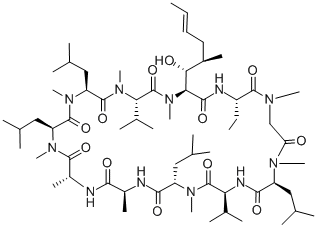
Product name:Cyclosporin A
CAS:59865-13-3
Molecular Formula:C62H111N11O12
Formula Weight:1202.61
Specification:250mg
Description:
Ciclosporin, cyclosporine (USAN), cyclosporin (former BAN) or cyclosporin A, is an immunosuppressant drug widely used in post-allogeneic organ transplant to reduce the activity of the patient's immune system, and therefore the risk of organ rejection. It has been studied in transplants of skin, heart, kidney, liver, lung, pancreas, bone marrow, and small intestine.
Cyclosporin A is a lipophilic cyclic polypeptide isolated from the cultures of some Hyphomycetes fungi, such as Cylindrocarpon lucidum and Tolypocladium inflatum. It has been widely used as an immunosuppressant in the 1980s and is now used in many groups. Tissue and organ transplantation for prevention of rejection and treatment of immune diseases.
Cyclosporin A is a strong immunosuppressive agent, which can inhibit the response of cell mediators, reversibly inhibit T cell proliferation, not inhibit the formation of blood cells, nor affect the function of phagocytes. Therefore, compared with other inhibitors, it has the advantages of less inducing or aggravating infection. It is mainly used in kidney, liver, heart, heart, etc. Anti-rejection of lung and bone marrow transplantation can be combined with adrenocortical hormone, but not with other immunosuppressive agents. It is also used in some autoimmune diseases (such as systemic lupus erythematosus, lupus nephritis, rheumatoid arthritis, autoimmune hemolytic anemia). It can be used in ocular pigmentitis, severe aplastic anemia, refractory idiopathic thrombocytopenic purpura, psoriasis and so on.
Cyclosporin A can reversibly and selectively change the function of T lymphocyte, prevent the transcription of lymphokine gene, interfere with the transmission of original information, inhibit the release of interleukin-2, interferon and other immune factors, affect humoral and cellular immunity, inhibit the killing activity of NK cells, and inhibit the lymphocyte in antigen. Differentiation and proliferation stimulated by mitogen. However, it has no activity to bone marrow, little effect on B cells, and no significant inhibitory effect on the survival of granulocytes at the therapeutic dose. Oral digestion and absorption were slow and incomplete, only 4%-60%, with an average dose of 30%. Relative bioavailability was 20%-50%. The peak value reached 2-8 hours after oral administration, with an average of 3.5 hours. Individual differences were significant, such as the relative bioavailability of kidney transplantation patients was 5%-89%, and that of liver transplantation patients was 8%-60%. This product is a fat-soluble drug. Eating and eating greasy food can increase absorption. Lack of bile, depression, slow gastric emptying, increased gastrointestinal peristalsis, pancreatic dysfunction and fatty dysentery all affect the absorption of this product.

